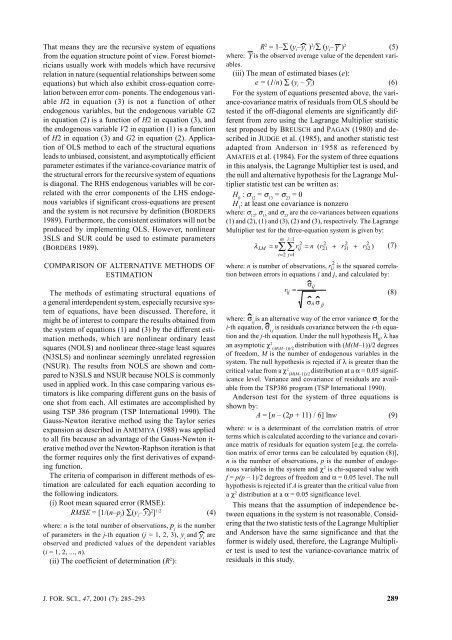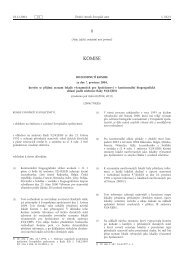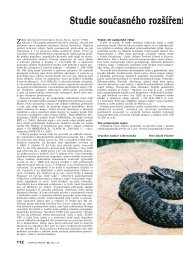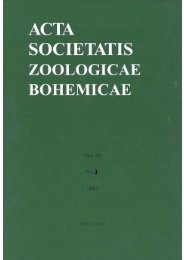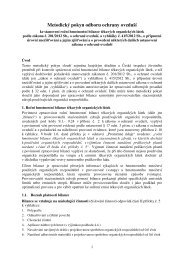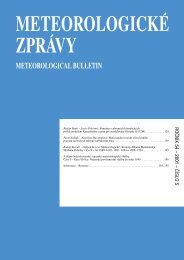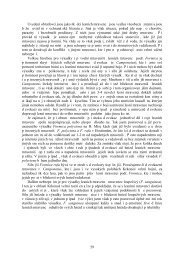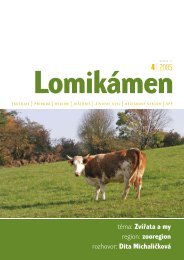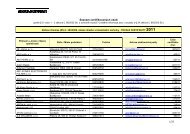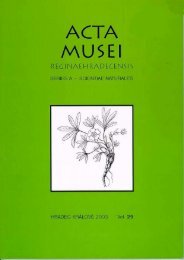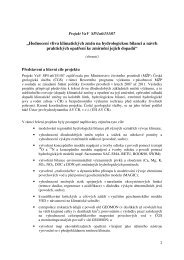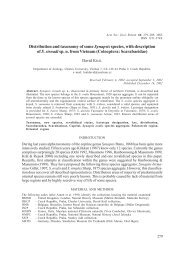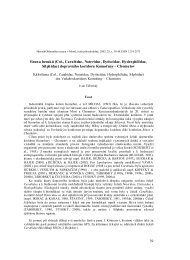journal of forest science
journal of forest science
journal of forest science
Create successful ePaper yourself
Turn your PDF publications into a flip-book with our unique Google optimized e-Paper software.
That means they are the recursive system <strong>of</strong> equations<br />
from the equation structure point <strong>of</strong> view. orest biometricians<br />
usually work with models which have recursive<br />
relation in nature (sequential relationships between some<br />
equations) but which also exhibit cross-equation correlation<br />
between error com- ponents. The endogenous variable<br />
H2 in equation (3) is not a function <strong>of</strong> other<br />
endogenous variables, but the endogenous variable G2<br />
in equation (2) is a function <strong>of</strong> H2 in equation (3), and<br />
the endogenous variable V2 in equation (1) is a function<br />
<strong>of</strong> H2 in equation (3) and G2 in equation (2). Application<br />
<strong>of</strong> OLS method to each <strong>of</strong> the structural equations<br />
leads to unbiased, consistent, and asymptotically efficient<br />
parameter estimates if the variance-covariance matrix <strong>of</strong><br />
the structural errors for the recursive system <strong>of</strong> equations<br />
is diagonal. The RHS endogenous variables will be correlated<br />
with the error components <strong>of</strong> the LHS endogenous<br />
variables if significant cross-equations are present<br />
and the system is not recursive by definition (BORDERS<br />
1989). urthermore, the consistent estimators will not be<br />
produced by implementing OLS. However, nonlinear<br />
3SLS and SUR could be used to estimate parameters<br />
(BORDERS 1989).<br />
COMPARISON O ALTERNATIVE METHODS O<br />
ESTIMATION<br />
The methods <strong>of</strong> estimating structural equations <strong>of</strong><br />
a general interdependent system, especially recursive system<br />
<strong>of</strong> equations, have been discussed. Therefore, it<br />
might be <strong>of</strong> interest to compare the results obtained from<br />
the system <strong>of</strong> equations (1) and (3) by the different estimation<br />
methods, which are nonlinear ordinary least<br />
squares (NOLS) and nonlinear three-stage least squares<br />
(N3SLS) and nonlinear seemingly unrelated regression<br />
(NSUR). The results from NOLS are shown and compared<br />
to N3SLS and NSUR because NOLS is commonly<br />
used in applied work. In this case comparing various estimators<br />
is like comparing different guns on the basis <strong>of</strong><br />
one shot from each. All estimates are accomplished by<br />
using TSP 386 program (TSP International 1990). The<br />
Gauss-Newton iterative method using the Taylor series<br />
expansion as described in AMEMIYA (1988) was applied<br />
to all fits because an advantage <strong>of</strong> the Gauss-Newton iterative<br />
method over the Newton-Raphson iteration is that<br />
the former requires only the first derivatives <strong>of</strong> expanding<br />
function.<br />
The criteria <strong>of</strong> comparison in different methods <strong>of</strong> estimation<br />
are calculated for each equation according to<br />
the following indicators.<br />
(i) Root mean squared error (RMSE):<br />
RMSE = [1/(n–pj) ∑(yi– ) 2 ] 1/2 (4)<br />
where: n is the total number <strong>of</strong> observations, p is the number<br />
j<br />
<strong>of</strong> parameters in the j-th equation (j = 1, 2, 3), y and are<br />
i yi observed and predicted values <strong>of</strong> the dependent variables<br />
(i = 1, 2, ..., n).<br />
(ii) The coefficient <strong>of</strong> determination (R 2 ):<br />
y i<br />
R<br />
where: Y is the observed average value <strong>of</strong> the dependent variables.<br />
(iii) The mean <strong>of</strong> estimated biases (e):<br />
e = (1/n) ∑ (yi – yi) (6)<br />
or the system <strong>of</strong> equations presented above, the variance-covariance<br />
matrix <strong>of</strong> residuals from OLS should be<br />
tested if the <strong>of</strong>f-diagonal elements are significantly different<br />
from zero using the Lagrange Multiplier statistic<br />
test proposed by BREUSCH and PAGAN (1980) and described<br />
in JUDGE et al. (1985), and another statistic test<br />
adapted from Anderson in 1958 as referenced by<br />
AMATEIS et al. (1984). or the system <strong>of</strong> three equations<br />
in this analysis, the Lagrange Multiplier test is used, and<br />
the null and alternative hypothesis for the Lagrange Multiplier<br />
statistic test can be written as:<br />
H : σ = σ = σ = 0<br />
0 12 13 23<br />
H : at least one covariance is nonzero<br />
1<br />
where: σ , σ and σ are the co-variances between equations<br />
12 13 23<br />
(1) and (2), (1) and (3), (2) and (3), respectively. The Lagrange<br />
Multiplier test for the three-equation system is given by:<br />
2 = 1–∑ (yi– ) 2 /∑ (yi– ) 2 yi Y<br />
(5)<br />
2<br />
where: n is number <strong>of</strong> observations, ri<br />
j<br />
is the squared correlation<br />
between errors in equations i and j, and calculated by:<br />
rij<br />
=<br />
σij<br />
σii<br />
σ jj<br />
(8)<br />
where: is an alternative way <strong>of</strong> the error variance σ for the i<br />
i-th equation, is residuals covariance between the i-th equation<br />
and the j-th equation. Under the null hypothesis H , λ has 0<br />
an asymptotic χ2 distribution with (M(M–1))/2 degrees<br />
(M(M–1))/2<br />
<strong>of</strong> freedom. M is the number <strong>of</strong> endogenous variables in the<br />
system. The null hypothesis is rejected if λ is greater than the<br />
critical value from a χ2 σi j<br />
distribution at a α = 0.05 signif-<br />
(M(M–1))/2<br />
icance level. Variance and covariance <strong>of</strong> residuals are available<br />
from the TSP386 program (TSP International 1990).<br />
Anderson test for the system <strong>of</strong> three equations is<br />
shown by:<br />
A = [n – (2p + 11) / 6] lnw (9)<br />
where: w is a determinant <strong>of</strong> the correlation matrix <strong>of</strong> error<br />
terms which is calculated according to the variance and covariance<br />
matrix <strong>of</strong> residuals for equation system [e.g. the correlation<br />
matrix <strong>of</strong> error terms can be calculated by equation (8)],<br />
n is the number <strong>of</strong> observations, p is the number <strong>of</strong> endogenous<br />
variables in the system and χ 2 is chi-squared value with<br />
f = p(p – 1)/2 degrees <strong>of</strong> freedom and α = 0.05 level. The null<br />
hypothesis is rejected if A is greater than the critical value from<br />
a χ 2 distribution at a α = 0.05 significance level.<br />
This means that the assumption <strong>of</strong> independence between<br />
equations in the system is not reasonable. Considering<br />
that the two statistic tests <strong>of</strong> the Lagrange Multiplier<br />
and Anderson have the same significance and that the<br />
former is widely used, therefore, the Lagrange Multiplier<br />
test is used to test the variance-covariance matrix <strong>of</strong><br />
residuals in this study.<br />
J. FOR. SCI., 47, 2001 (7): 285–293 289<br />
σ ii<br />
λ<br />
LM<br />
= n<br />
m i=<br />
1<br />
2<br />
∑∑rij<br />
i=<br />
2 j=<br />
1<br />
= n ( r<br />
2<br />
21<br />
+<br />
2<br />
31<br />
r<br />
+<br />
2<br />
32<br />
r<br />
)<br />
(7)


